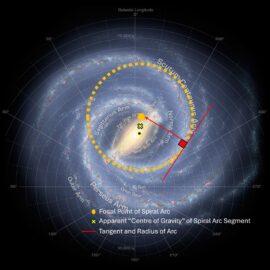In the ultimate post of the series, we finally get to add some of the things that we image in galaxies – emissions, dust, and stars, to the stuff we can’t see – hydrogen and black holes. The stuff we can see brings life to the galaxy and are indeed necessarily for its longevity and new star production.
Gravity is shown to be periodic both in radial and angular directions, just like the spiral, but the various forces at play effect the galactic jewelry in different ways to give us regions of emissions, dust lanes, and star orbits. Explanations are provides as to why the arms can extend for radii way beyond what we do see, why dark matter is unnecessary (just a hydrogen accounting error). The spiral structure even explains why velocity vs radius plots look periodic when even dark matter doesn’t explain it.
Circulation and Jewelry – The Galactic Spiral Structure (Part 5)



